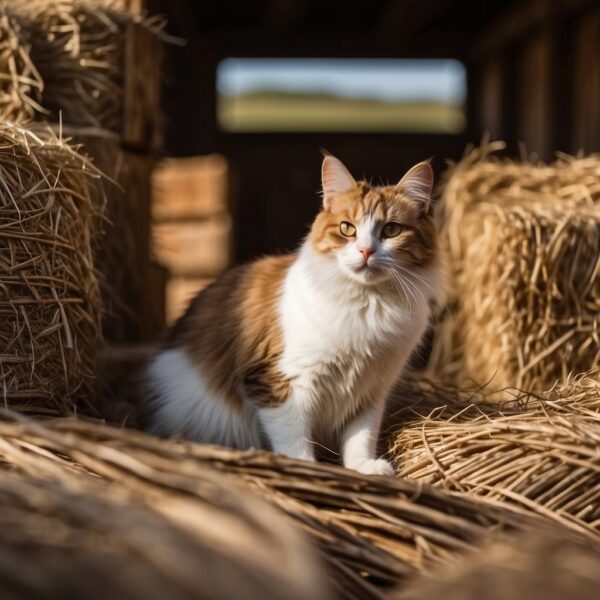
What is a Barn Cat?
A barn cat is a domestic cat that has adapted to life in an agricultural environment, providing a multifaceted role as a pest controller, and at times, a companion. Farm cats are typically of mixed breed and can be found in a range of appearances due to their diverse genetic backgrounds. These cats often live outdoors, thriving in a feral or semi-feral state, and are usually known for their independent and resilient nature.
They can be found sheltering in various outbuildings on farms, where they hunt vermin such as rodents that pose a threat to crops and stored produce. While some barn cats may develop bonds with humans and exhibit tame behavior, others may remain elusive and detached, with limited interaction with people. The presence of barn cats on a farm can lead to a mutually beneficial relationship, as the cats help to control the pest population while often receiving basic care and shelter.
Key Takeaways
- Barn cats are domestic cats that often live outdoors and serve as natural pest controllers on farms.
- These cats can vary greatly in appearance and behavior, ranging from feral to friendly towards humans.
- Although independent by nature, barn cats can form a symbiotic relationship with farmers, benefiting from shelter and care while they manage pests.
Understanding Barn Cats
Barn cats have a significant role on farms, known for their prowess in rodent control and contributing to a balanced rural ecosystem.
Definition and History
Barn cats, commonly identified as farm cats or working cats, are felines that typically reside on agricultural land, including farms and ranches. History suggests these cats began cohabitating with humans when farming communities stored surplus grains, which attracted rodents and, in turn, these feline hunters. Initially, domestication arose from mutual benefit: humans provided shelter, and cats handled pest control. Over time, some of these cats have lived as semi-feral or fully feral cats, with the former being somewhat accustomed to human interaction and the latter having little to no contact with people.
Characteristics of Domestication
Barn cats display diverse features due to their mixed breeds, often including lineages from Maine Coon or American Wirehair. These cats exhibit:
| Physical Traits | Behavior |
|---|---|
| Mixed breed appearances | Strong hunting instincts |
| Variable coat patterns | Independent lifestyle |
Domestication has equipped barn cats with abilities to thrive in rural environments. They have developed a unique set of survival skills, and while they might develop bonds with humans, many maintain their independence, often living a life in between a traditional domestic cat and the untamed ways of a feral cat.
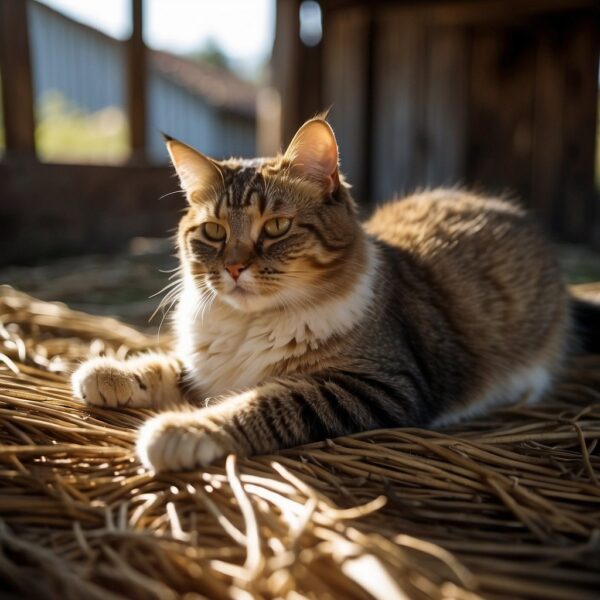
Roles and Responsibilities
Barn cats fulfill essential roles in maintaining the equilibrium of rural and farming environments. Notably, their presence deters rodents and contributes to territory management. These independent felines exhibit a strong hunting instinct and play a vital role in pest control, helping preserve the health and safety of barn ecosystems.
Rodent Control
Primary Objective: Barn cats are a natural solution to rodent control, skillfully keeping the rodent population at bay. Their hunting prowess is not only a behavior but a critical service in protecting feed and grain from vermin.
- Tactics: Integral to barn cats’ roles is their ability to hunt and capture various pests such as mice, rats, and other small vermin. As natural predators, they are:
- Inherently skilled in tracking and catching rodents
- Able to significantly reduce the nuisance caused by vermin without the need for chemical pest control measures
Property and Territory Management
Key Function: Beyond pest control, barn cats contribute to managing the territory of a rural property. Their presence alone can be a deterrent to potential rodent invaders.
- Strategies: By establishing their domain within and around the barn, they oversee their territory and dissuade new pests from settling in. Regularly patrolling their allocated space is how these felines assert their role.
Note: While barn cats may limit the ingress of rodents and other small pests, they do not replace regular upkeep and pest management practices necessary for maintaining farm sanitation and health.
Health and Welfare
The health and welfare of barn cats are paramount, requiring attention to disease prevention and access to veterinary care. Understanding the challenges of managing diseases and parasites, as well as the importance of regular veterinary care and vaccination, helps ensure the well-being of these working animals.
Diseases and Parasites
Barn cats can be exposed to a variety of diseases and parasites, which can affect their health and longevity. Two common external parasites are fleas and ticks, which not only cause discomfort but can also transmit diseases to cats. For example, ticks can carry Lyme disease, which can lead to serious health complications.
Internal parasites, such as worms, are also a concern for farm cats. These parasites can cause weight loss, malnutrition, and anemia, adversely affecting a cat’s overall well-being. Regular deworming and external parasite control are essential in maintaining a barn cat’s health.
Veterinary Care and Vaccination
Veterinary care plays a critical role in the welfare of farm cats. These cats should be vaccinated against common feline diseases, such as feline leukemia virus (FeLV), feline immunodeficiency virus (FIV), rabies, and upper respiratory infections. Vaccinations help reduce the spread of infectious diseases and are a vital part of routine health care for barn cats.
Barn cat programs typically ensure that cats receive a veterinary health check, are spayed or neutered, and are vaccinated before placement. Regular check-ups can help detect any health issues early on, reducing the risk of illness and potential spread to other animals. Access to emergency veterinary care is also crucial in the event of an injury or acute illness.
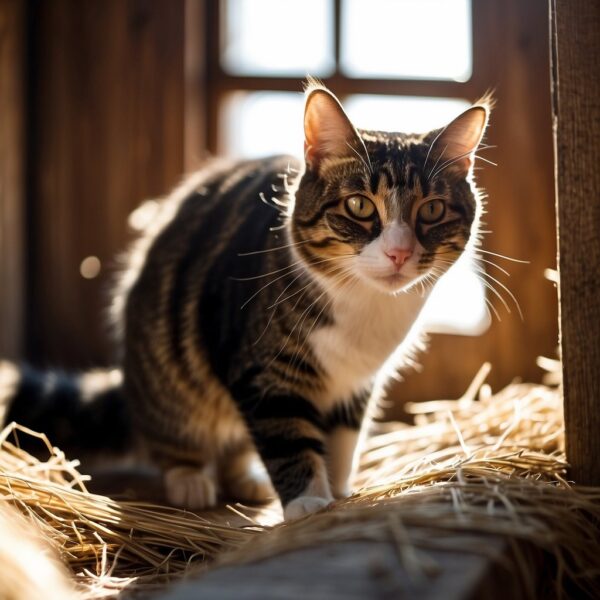
Farm Cat Care Guidelines
Caring for barn cats involves providing appropriate shelter to ensure safety and supplying adequate food and water for their nutrition and hydration.
Shelter and Safety
Shelter is critical for barn cats to protect them from the elements and predators. A barn cat’s shelter should be dry, warm, and insulated to guard against cold and wet weather. The area should be safe from chemicals and machinery that could be hazardous. Easy access in and out of the shelter is essential for the cat’s independence.
Feeding and Hydration
Barn cats require consistent access to fresh water and nutritious cat food. They should not rely solely on hunting for sustenance.
- Food: Offer measured amounts of commercial cat food twice daily to maintain their health. Avoid leaving food out to ensure it does not attract other animals.
- Water: Always provide a supply of clean, unfrozen water in a sheltered location to prevent dehydration.
Adoption and Integration
When adopting a barn cat, prospective guardians navigate a structured process to ensure the cat transitions smoothly from shelter to outdoor lifestyle. These cats typically help manage rodent populations in rural or farm settings and require certain conditions for successful integration.
The Adoption Process
Adoption involves a few critical steps that match farm cats with suitable homesteads. Guardians might pay an adoption fee or provide a donation which usually covers initial veterinary services such as neutering, vaccination, and parasite control. To adopt, one generally must demonstrate a safe, suitable environment for the cat, often on a farm, ranch, or other rural property.
- Evaluation: Shelters assess the cat’s temperament and suitability for outdoor life.
- Matching: Cats are paired with an environment that suits their temperament and needs.
- Adoption Agreement: Adopters agree to provide ongoing care, including food, water, and shelter.
- Post-Adoption Support: Some organizations offer guidance post-adoption to ensure successful integration.
Acclimation to Rural Life
Newly adopted barn cats require a specific acclimation period to adjust to their new environment and establish it as their territory. This process prevents cats from trying to return to their previous location and encourages bonding with their new human caretakers while maintaining the desired level of independence.
- Confinement: Cats are initially kept in a secure area, like a barn or a large crate, to prevent them from fleeing and to familiarize them with their new home.
- Gradual Introduction: Over time, they are allowed to explore more territory under supervision.
- Human Interaction: Limited interaction helps establish trust without compromising the cats’ natural behaviors essential for controlling the rodent population.
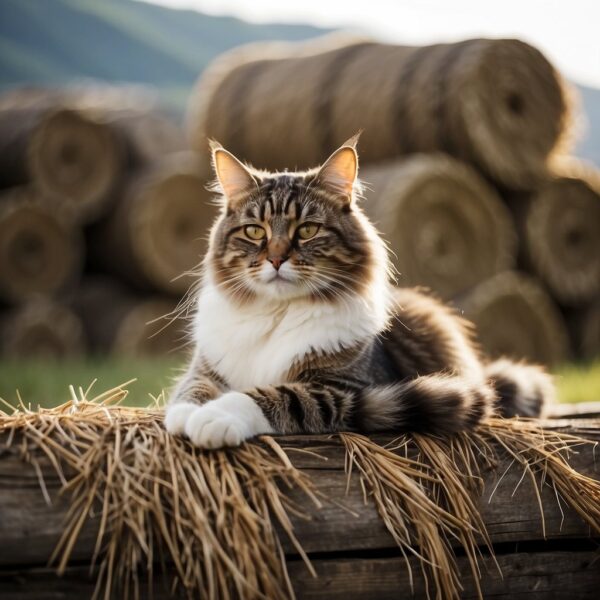
Coexistence with Humans
Barn cats, with their distinctive lifestyle, serve as both companions and functional residents on farms and agricultural properties. They dwell in outbuildings and barns, contributing significantly to property maintenance and keeping a natural balance.
Benefits to Farms and Homesteads
Farm cats offer indispensable support on agricultural properties. They are renowned for their ability to control rodent populations, providing a natural form of pest management. Here’s how farm cats benefit farms and homesteads:
- Rodent Control: They reduce crop and feed losses by hunting vermin on the property.
- Disease Prevention: By keeping rodent numbers in check, barn cats help limit the spread of diseases that could affect livestock and humans.
- Chemical-Free Solution: They provide an eco-friendly alternative to poisons and traps.
Interactions and Bonding
Although barn cats might maintain a more independent lifestyle compared to house cats, they do interact with humans and can form bonds.
- Human Interaction: Handlers often provide them with basic needs like food and water, which can facilitate interaction and foster trust over time.
- Companionship: While tending to chores in barns, greenhouses, and other outbuildings, farmers might enjoy the casual company of barn cats. Those that are socialized can offer occasional companionship to humans.
Common Challenges
Barn cats fulfill an important role in controlling rodent populations on farms; however, they face numerous risks and challenges in their environment.
Risk Factors
Barn cats often encounter various risks while performing their natural hunting duties. The search for prey can lead them to dangerous encounters with vehicles or other predators, which can result in injury or death. Even within their territories, barn cats may engage in fighting with other cats, leading to wounds that, without proper care, can become serious health issues.
Engagement in hunting can also expose these semi-feral cats to various parasites and diseases. The presence of thick undergrowth or debris creates a hazard, where cats can get cuts or scrapes that may become infected. Additionally, their predatory nature does not protect them from becoming prey themselves to larger predators, such as coyotes or birds of prey.
Population Management
Managing the population of barn cats is critical; overpopulation can lead to insufficient resources and increased disease transmission. Spaying and neutering are vital practices that help prevent the rise of unwanted litters. Yet, these practices are not always observed, leading to spikes in the farm cat populations and, consequently, more competition for food and territory.
With many barn cats living a semi-feral lifestyle, controlling their breeding becomes more challenging, necessitating more concerted efforts from barn owners. These population management efforts are not just for the welfare of the barn cats but also to maintain the balance within the ecosystem where they serve their role.
Barn Cats Special Considerations
When it comes to barn cats, there are special considerations that ensure their safety and happiness. They require specific care during harsh weather and a commitment to their long-term well-being.
Winter Care
During winter, barn cats need shelter that keeps them warm and safe from the elements. Insulation is key. Straw, not hay, is recommended for bedding as it doesn’t retain moisture. Ensuring they have a dry, draft-free enclosure can protect them from cold temperatures. Heated water bowls should replace standard water bowls to prevent freezing, guaranteeing access to liquid water is essential.
Long-term Commitment
Barn cats are a low-maintenance but valued part of a farm or rural setting. Their care extends beyond food; they require ongoing attention to their health and environment. Regular veterinary care, including vaccinations and deworming, is essential for their longevity. While they might roam freely, it’s important that their presence is seen as a commitment, ensuring they lead happy and healthy lives.
Helpful Information
In this section, readers will gain insight into the specific characteristics of barn cats and the essentials of providing them with appropriate care. Understanding these elements ensures these feline residents can thrive in their roles.
Attributes of Barn Cats
Barn cats tend to display independence and a self-sustaining temperament, making them well-suited for outdoor life. They are often mixed breed cats with varying appearances and have developed strong rodent control abilities. They are typically hardy and healthy, adapted to their life outside. Temperament can range from feral to semi-feral, and less commonly, barn cats may exhibit a domesticated personality, although this is not their primary role on a farm.
| Key Attribute | Description |
|---|---|
| Independence | They maintain a self-sufficient lifestyle, mostly outdoors. |
| Mixed Breed | Barn cats come from diverse genetic backgrounds. |
| Rodent Control Expertise | They excel at managing pest populations naturally. |
| Temperament | They can be feral, semi-feral, or occasionally more tame. |
| Adaptability to Outdoors | They are conditioned to live and thrive outside. |
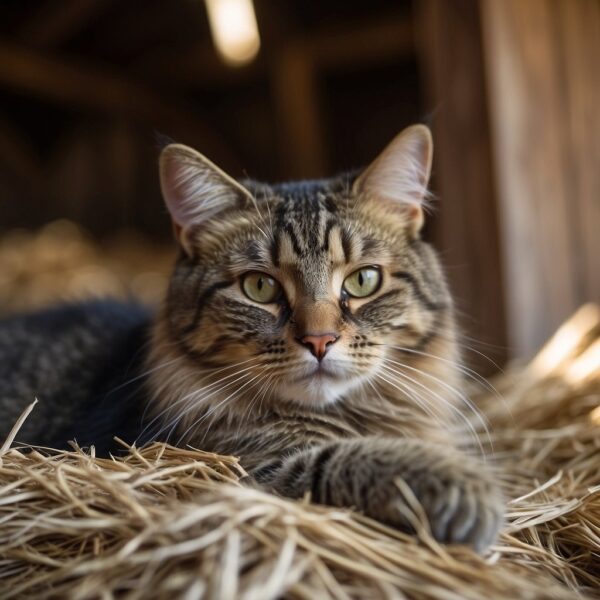
Frequently Asked Questions about barn cats
Barn cats, often mixed-breed descendants from feral or stray cats, have unique roles and behaviors. They are commonly found on farms and their care differs from that of a typical household pet. Below are specific questions that address common inquiries about barn cats.
How do barn cats differ from feral cats?
Barn cats may originate from feral backgrounds but typically have acclimated to human presence, often around farms where they control rodent populations. They differ from feral cats, which are entirely wild and generally avoid human contact.
Can barn cats be transitioned to indoor pets?
Transitioning barn cats to indoor life is possible but challenging. They are accustomed to the freedom of the outdoors and may not adjust well to indoor confinement. Each cat’s adaptability will vary.
What are the typical behaviors of barn cats?
Barn cats exhibit behaviors such as hunting rodents, roaming their territory, and finding shelter in barns or other farm structures. They tend to avoid close human interaction but can become more sociable over time.
What roles do barn cats serve on a farm?
On a farm, barn cats serve the crucial role of pest control, naturally keeping down the rodent population. They are valued for their independent spirits and their contribution to maintaining the ecosystem balance.
Do barn cats require a litter box?
Barn cats typically do not require a litter box as they use the outdoors to relieve themselves. However, providing a litter box can be beneficial if they spend considerable time inside a barn or during harsh weather conditions.
What should one consider before adopting a barn cat?
Before adopting a barn cat, consider the cat’s environmental needs, including shelter, food, and water. Make sure to ensure regular veterinary care for vaccinations and pest control. Lastly, consider the cat’s safety and how it will be integrated into the farm setting.